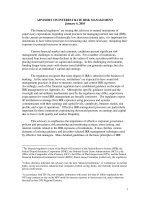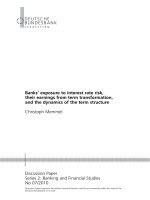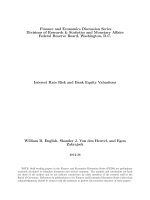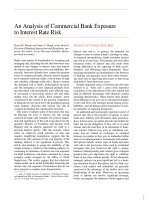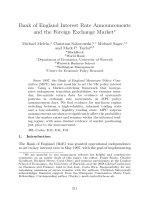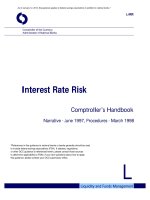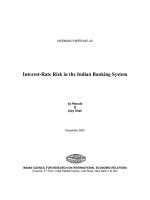Interest Rate Risk and Bank Common Stock Returns: Evidence from the Greek Banking Sector pot
Bạn đang xem bản rút gọn của tài liệu. Xem và tải ngay bản đầy đủ của tài liệu tại đây (138.08 KB, 27 trang )
Interest Rate Risk and Bank Common Stock
Returns: Evidence from the Greek Banking
Sector
Konstantinos Drakos
Department of Economics
London Guildhall University
31 Jewry Street
London
EC3N 2EY
UK
Tel: (++44) 0207 320 3096
Email:
2
Abstract
The paper explores the effect of changes in the long-term interest rate on the common
stock returns of banks listed in the Athens Stock Exchange. Two alternative
econometric strategies are followed. First, in a single equation framework the interest
rate sensitivity of stock returns is tested, allowing for time-varying conditional
volatility. Then, 'pooling' information across stocks, a system-theoretic approach is
employed where explicitly interdependence of stocks is exploited. The findings from
both methods were consistent providing evidence for significant sensitivity of bank
stock returns to interest rate movements. Working capital was found as the variable
that may account for the cross-sectional variation of the interest-rate sensitivities
providing evidence for the nominal contracting hypothesis.
Keywords: APT, Bank Common Stock Returns, GARCH-modelling, Seemingly
Unrelated Regressions (SURE)
JEL classification: C22, C32, E43, G12
3
1. Introduction
Stock returns sensitivity to interest rates was theoretically advocated by
Merton (1973), Long (1974) and Stone (1974). Essentially, risk averse investors
demand higher compensation for exposure to factors, other than the market
portfolio, that are correlated with intertemporal changes in the investment
opportunity set. Merton suggested that the level of market interest rates might
provide a proxy for shifts in the investment opportunity set (Flannery et. al,
1997).
Therefore, if a risk averse investor is choosing between two assets giving
the same distribution of future wealth but exhibiting differential sensitivity to
interest rates (in terms of covariance), then she will select the portfolio that
provides better hedging services against unfavourable movements in interest rates
(Yourougou, 1990).
Empirical investigation of stock returns interest rate sensitivity has
produced evidence in favour of the existence of such sensitivity. For instance
Fama and Schwert (1977) and Fogler et al. (1981) have shown that the inclusion
of an interest rate factor adds substantially to the explanatory power of the single-
factor model. Also, Sweeny and Warga (1986), Yourougou (1990) report that for
a subset of securities interest rate risk is present.
The issue of interest rate sensitivity of bank common stock returns is of
major interest for regulators, banks and academics for that reason a voluminous
literature has explored the issue. Empirical studies have provided substantial
evidence for bank stock returns exhibiting statistically significant inverse
relationship with interest rate changes (Flannery and James, 1984; Brewer and
4
Lee, 1985; Scott and Peterson, 1986; Kane and Unal, 1988; Saunders and
Yourougou, 1990; Kwan, 1991; Akella and Greenbaum, 1992; Choi et al., 1992).
The research interest on the issue has been recently revived, attracting
more attention in the empirical literature producing a new wave of further
evidence for a significant negative relationship between bank stock returns and
interest rate changes (Choi et al., 1996; Allen and Jagtiani, 1997; Flannery et al.,
1997; Elyasiani and Mansur, 1998; Benink and Wolff, 2000; Jianping and Zheng
Wang, 2000). However, Choi et al. (1996), Allen and Jagtiani, (1997) and Benink
and Wolff, (2000) conclude that interest rate sensitivity has decreased in the late
1980's and early 1990's due to the availability of interest rate derivatives contracts
that can be used for hedging purposes.
The bulk of the research has almost exclusively focused on the US banking
sector. The present study will investigate the interest rate sensitivity of the Greek
banking sector.
The paper makes two main contributions. First, in methodological terms a
robust way is used in order to test for interest rate sensitivity of bank common
stock returns, both within a single equation framework model (allowing for time-
varying conditional volatility) and also in a systems framework. The second
contribution of the paper is that it tests whether bank sensitivity to interest rates is
uniform across banks. Additionally, it investigates the possible determinants of
the apparent cross-sectional variability in the interest rate sensitivity parameters.
The importance of the study stems from the fact that financial
intermediaries play a crucial role in economic growth. In the case of emerging
markets, like the Greek, financial intermediaries play an even more significant
role in the development process (Bencivenga and Bruce, 1991; King and Levine,
5
1993; Levine and Zervos, 1998). Therefore, studying the effects of interest rate
movements on bank stock returns is of great significance for policy design.
Additionally, knowing the nature of this relationship can also provide valuable
information for portfolio management purposes both domestically, as well as,
internationally. Given the increased comovement of mature financial markets,
diversification gains could be exploited by turning investment attention to
emerging markets like the Greek.
As discussed above recent studies for the US banking sector have
concluded that interest rate sensitivity has decreased in the late 1980's and early
1990's due to the availability of interest rate derivatives contracts for hedging
purposes (Choi et al., 1996; Allen and Jagtiani, 1997; Benink and Wolff, 2000).
However, Greek banks did not have access to a local derivatives market in order
to use such contracts for hedging purposes. The Athens Derivatives Exchange
(ADEX) was only established in April 1998 offering a restricted set of contracts.
So interest rate exposure could not be explicitly hedged until recently.
In particular the present study will address the following research
questions:
• Do bank common stock returns exhibit significant sensitivity to changes in
the long-term interest rate?
• Then, if indeed the sensitivity is significant, is there a negative relationship
between stock returns and interest rate changes?
• Is interest rate sensitivity uniform across banks?
• If uniformity is rejected, in favour of heterogeneity, which are its
determinants?
6
Addressing these questions will assist in understanding the interest rate risk
exposure of the Greek banking sector and will also provide evidence for an
emerging market. The latter will allow for a comparison between capital markets
of different depth and maturity.
The paper will be organised as follows. Section 2 will provide a brief
literature review. Section 3 will summarise the data employed. Section 4 will
outline the econometric methodology. Section 5 will discuss the empirical
findings and finally, Section 6 will conclude.
2. Literature Review
There are two strands of the literature. The first one explores interest rate
sensitivity of bank stock returns by assuming and explicitly testing a two-factor
model based on the Arbitrage Pricing Theory (APT, hereafter) developed by Ross
(1976). The two factors 'driving' stock returns are typically identified as the
market portfolio (M) and changes in the long-term interest rate (I). The general
form of the APT model assumes the following return generating process:
where R
i,t
is the observed return on security i at time t, E(R
i,t
) is the expected
(unobserved) return on security i at time t, F
j,t
is the level of market factor j at time
t and [F
j,t
- E(F
j,t
)] measures the unexpected change in factor j at time t,
β
i,j
is the
sensitivity of stock i to factor j. Finally,
ε
i,t
is the specific error for security i at time
t. It is assumed that the specific errors are serially uncorrelated and orthogonal to
unexpected change in the factor j. Assuming no arbitrage opportunities one can
[]
∑
=
+−+=
k
j
tijtjijtiti
FEFRER
1
,,,,
(1) )()(
εβ
7
show that the expected return on a security is linearly related to the risk premia
on the above mentioned factors:
where
α
0
is the risk-free rate or the return on the zero-beta portfolio and
α
j
is the
risk premium associated with the risk factor j. Substituting (2) in (1)and
rearranging, gives:
If a two-factor APT model is assumed where the factors are identified as the
market portfolio and long-term interest rate changes, then (3) can be written as:
where R
M,t
is the return on the market portfolio and I
,t
the long-term bond yield.
Estimation of model (4) requires full information maximum likelihood (FIML) in
order to estimate in one step the factor loadings (betas) and the risk premia
(alphas). In this context one is testing whether stock returns are sensitive to
interest rate changes (significance of
β
I
) and also whether interest rate risk is
priced in equilibrium (significance of
α
2
). The empirical findings are mixed
suggesting that bank stock returns are sensitive to interest rate changes. However,
explicit pricing or interest rate risk is not undoubtedly established.
The second strand of the literature does not test the restrictions imposed by
an explicit two-factor APT model, although such a return generating process is
implicitly assumed in the background. In this framework a more flexible testing
(2) )(
1
0
∑
=
+=
k
j
ijji
RE
βαα
[]
(3) )((
11
,0,
∑∑
++−+=
==
k
j
k
j
tijtijijjjti
FFER
εββαα
[][]
(4) )()(
,,,,,2,10, titIitMMiIiMimti
IRIERER
εβββαβαα
+++−+−+=
8
approach is followed where interest rate sensitivity is of main concern. The model
is assumed to take the following general form:
where variation of stock returns is assumed to depend on a set of variables X
i
,
which could well include past returns on the stock, and changes on the long-term
interest rate (
∆
I). This unconstrained set up can also accommodate time-varying
conditional volatilities.
Estimating models in the form of (4) has the advantage of providing a
robust statistical framework where sensitivity and equilibrium pricing of interest
rate exposure are simultaneously tested. Its main disadvantage is the inability,
due to computational complexity, to capture the stylised fact of time-varying
conditional volatility in stock returns. On the other hand, models of the form of
(5) lack in terms of theoretical foundation but have the attractive feature of
potentially incorporating stochastic volatility effects.
The present study will attempt to 'merge' in a way the two approaches by
testing a hybrid model that is a combination of models (4) and (5). An elaborate
discussion on this will be given in section 4.
3. Data Issues and Summary Statistics
The dataset consists of the daily closing of nine bank common stock prices
listed in the Athens Stock Exchange (ASE) from 14/11/1997 to 16/11/2000
providing 785 observations for each stock. The banks included in the sample are
(in alphabetical order)
1
: ALPHA BANK, ATTICA BANK, COMMERCIAL
BANK OF GREECE, EGNATIA BANK, EUROBANK, GENERAL
(5)
1
,0
∑
+∆++=
=
n
i
tttiit
IXR
εθφφ
9
HELLENIC BANK, NATIONAL BANK OF GREECE, NIBID, PIREAUS
BANK.
Additionally, the closing price of the General Bank Index was sampled for
the same period. The long-term interest rate chosen was the 10-year swap rate. As
a proxy for the risk-free rate (in order to calculate excess returns) the One-week
Interbank rate was chosen. Finally, a set of financial variables from the banks’
balance sheets
2
was used including the following: Market Value, Total Debt,
Equity, Working Capital, Market-to-Book Ratio and Total Assets. All data series
were obtained from the DataStream's database.
As background information it is interesting to mention that 5 out of the 9
bank stocks included in the sample appear in the 12 most actively traded stocks in
the ASE
3
. Furthermore, the banking sector accounted on average for about 28%
of the market capitalisation during the sample period.
Weekly excess returns for each of the nine bank stocks were calculated as
follows:
where m = 5 (weekly returns), R
i,t
and XR
i,t
stand for the return and excess return
respectively for stock i at time t, and R
f,t
stands for the risk-free rate at time t
calculated as the holding period return of a One-week bond
4
. All returns were
annualised. Table 1 reports the summary statistics for all stocks as well as the unit
root tests (Dickey and Fuller, 1979, 1981).
[Table 1]
(7)
(6) 100*
,,,
,
,,
,
tftiti
ti
timti
ti
RRXR
P
PP
R
−=
−
=
+
10
As expected the null of non-stationarity was rejected for all excess returns
implying that standard asymptotic theory can be applied.
At this point it should be noted that typically in the literature the analysis
considers portfolios of banks stocks rather than individual stocks as it is done in
the present study. It is expected that the formation of portfolios would have the
advantage of smoothing out the noise in the data due to transitory shocks to
individual banks. An apparent disadvantage of such an approach, however, is that
it masks the dissimilarities in the micro level (Elyasiani and Mansur, 1998).
In the present study, however, the small number of stocks does not allow the
construction of financially meaningful portfolios. In other words, the analysis on
the one hand has the drawback that noise is not 'averaged out', but on the other
hand allows the evaluation of interest rate risk on the micro level (across banks).
4. Econometric Methodology
4.1 Single Equation framework
In order to test the interest rate sensitivity of bank common stock returns a
number of alternative models will be estimated. First, within a single equation
framework a variant of model (5) will be employed. In particular, the model to be
estimated has the form:
(8b)
(8a) ),0(~
(8)
1,
2
1,0,
,1
,1
1
0,
−−
−
=
−
++=
+∆+
∑
+=
tititi
tit-i,t
tit
k
j
jtjti
hh
h|Ωε
IXRXR
γβεα
εθφφ
11
where h
t
is the conditional variance of
ε
t
,
Ω
is the information set and
φ
0
,
φ
j
,
θ
,
α
0
,
β
,
γ
are parameters to be estimated.
In this model the excess return on the bank common stock is assumed to depend
on each history and conditional volatility is allowed to be time-varying generated
by a Generalised (potentially Integrated) Autoregressive Conditional
Heteroscedasticity (IGARCH) model (Bollerslev et al. 1986). Within this context,
interest rate (non-) sensitivity is tested by essentially testing the null hypothesis
that the parameter
θ
is insignificantly different from zero.
The use of the first difference of the long-term interest rate follows Sweeny
and Warga (1986) and Elyasiani and Mansun (1998) whom employ this measure
as a proxy for innovations in the interest rate
5
. The change in the interest rate is
introduced with a lag following Elyasiani and Masun (1998), in order to escape
any potential contemporaneous correlation of the shocks to the capital market
(error term) and the innovations in the interest rate that would result in estimator
inconsistency.
4.2 Systems framework
By recognising that bank stock returns are probably interrelated (either
because they are generated from the same data generation process or simply there
are shocks that affect the banking industry as a whole) resulting in statistical
interdependence of disturbances across stocks, then there must be efficiency gains
that can be exploited by estimating equation (8) as a system (across i's). Thus, the
equations in (8) are stacked to form a system of nine equations, which are
simultaneously estimated by using the 'seemingly unrelated regressions' method
(SURE) (Zellner, 1962). The model to be estimated takes the following form:
12
(9)
1
εθXRφφXR
ti,i
k
1j
jti,ji,0ti,
+++=
−
=
−
∑
t
ΔI
where
6
i = 1, 2, …9 (the number of banks in the sample) and XR
i,t
is an T x 1
vector of observations, and the vector of autoregressive coefficients takes the form
ϕ
ϕϕ
ϕ
i, j
=
[
φ
i,1
,
φ
i 2
]
'
, with θ
θθ
θ
i
=
[
θ
i
, …
θ
9
]
'
, and finally ε
εε
ε
i
is a vector of disturbances that
may be potentially correlated across equations such that:
where
σ
i, p
is the covariance between i and p disturbance terms.
Ideally, one would prefer to incorporate the GARCH effect in a
multivariate context, however computational difficulties preclude the estimation
of such a 'master' model that would essentially nest both (8) and a variant of (4).
In other words, allowing for interdependence across stocks comes at the cost of
dropping the assumption of time-varying conditional volatility.
However, treating stock returns as a system allows one to conduct two joint tests.
First, that stocks' sensitivity parameters to interest rate changes are jointly
significant and second, that they are of equal magnitude (stocks exhibiting
uniform interest rate sensitivity).
5. Empirical Results
5.1 Single equation models
Starting with the single equation framework, as a prelude, model (8)-8(c)
was estimated for the General Bank Index in order to explore whether the
aggregate measure of banks exhibits any interest rate sensitivity. Then the models
(10) 0I)ε(ε
npi
≠=
′
i,p
σE
13
were estimated for each of the nine bank stocks individually. Table 2 reports the
estimation results for weekly returns.
[Table 2]
Starting with the estimation results for the General Bank Index, interest-rate
sensitivity is present and also affecting negatively returns. Thus, this is informal
evidence suggesting the banks are jointly sensitive to interest rate innovations.
Also, the model captures the GARCH effect adequately. Moving now to the
micro-level, where bank stock returns' are viewed individually.
First the model exhibits sufficient explanatory power. In particular, the
coefficient of determination attains values between 73% and 77% approximately.
As far as the volatility equations are concerned, all parameters are highly
significant justifying the use of a GARCH model. The sum of (
β
+
γ
) is a measure
of volatility persistence, the closer to unity the higher the persistence in volatility.
In case the sum is equal to unity then the process is non-stationary and the so-
called Integrated GARCH (IGARCH) describes its behaviour. Moving to the
mean equations, the autoregressive parameters are highly significant implying
that excess returns are characterised by second-order dependence.
The weekly excess returns' sensitivity to interest rate changes, as measured
by the coefficient
θ
, is always negative as theory requires and is significant in 7
out of 9 cases. Therefore, there is substantial evidence that for weekly excess
returns when controlling for their past history and also allowing for time-varying
conditional volatility, one cannot reject that interest rate changes exert a
significant negative impact.
14
All in all, the single equation analysis has provided evidence for significant
negative interest rate sensitivity of bank common stock returns. These findings for
the Greek banking sector are in line with those reported for the US market.
As discussed in section 4.2 one would expect that excess returns are
interdependent and therefore estimating equation (8) as a system should be a
superior strategy since it would exploit the apparent efficiency gain. The next
section reports the results for the system estimation.
5.2 Systems framework
Treating model (8) as a system (across banks) produces nine equations
whose parameters are simultaneously estimated by the SURE method. Table 3
summarises the results for the weekly returns.
[Table 3]
The fit of the model is satisfactory ranging from 72% to 80%. What is
encouraging is that the results are qualitatively similar to those obtained from
estimating the equations separately. The coefficients measuring interest rate
sensitivity are all negative and 6 out of 9 are significant. A test of their joint
insignificance (all stock returns exhibiting zero interest rate sensitivity) was
comfortably rejected (see panel B of table 3). Also the hypothesis of uniform
interest rate sensitivity, where the null tested was that all interest rate coefficients
are equal in magnitude, was again rejected (see panel B of table 3).
Thus, the estimation of the SURE model in conjunction with the two
hypotheses tests provided strong evidence in favour of a significant sensitivity of
bank stock returns to interest rate movements. Furthermore, the sensitivity is far
from uniform implying that each stock exhibits idiosyncratic interest rate
15
sensitivity. The next section attempts to shed more light on the determinants of
this differential interest rate sensitivity.
5.3 The determinants of cross-sectional variation of interest-rate sensitivity
Given the rejection of the uniformity hypothesis an interesting exercise
would be to investigate the determinants of interest rate risk heterogeneity. In
other words, one would like to know what might account for the cross-sectional
variation in the interest-rate sensitivity parameters (
θ
's). A number of possible
explanations have been proposed in the literature as to why banks (or firms in
general) may exhibit heterogeneity in terms of their sensitivity to interest rate
movements. According to Flannery and James (1984), the cross-sectional
differences in bank stock interest rate sensitivities’ are related to their balance
sheet maturity composition. Flannery and James' analysis was based on the
concept of nominal contracting hypothesis (Kessel, 1956; Bach and Ando, 1957;
French et al., 1983). The nominal contracting hypothesis (NCH, hereafter)
postulates that a firm's holdings of nominal assets and nominal liabilities can
affect common stock returns through the wealth redistribution effects caused by
unexpected inflation. Unexpected inflation redistributes wealth from creditors to
debtors. Hence stockholders of firms with higher level of nominal liabilities than
nominal assets should benefit from unexpected inflation, while the opposite
should be true for the equity value of firms with the reverse position. This effect
will vary directly with the relative duration of the nominal contract. As duration
of the firm's nominal assets increases relatively to its nominal liabilities, so will do
the effect of unanticipated changes in inflation on the value of the equity (Kwan,
1991).
16
The link between bank stock returns and unexpected inflation is given by
interest rates. If movements in interest rates result primarily from changes in
inflationary expectations as Fama (1975, 1976) and Fama and Gibbons (1982)
have argued, then the NCH implies a relationship between interest rate
movements and common stock returns. Finally, according to Flannery and James
(1984), as interest rates change the common stock returns of a firm financed
entirely by equity and holding only nominal assets should behave like a bond with
a maturity equal to the average maturity of the firm's assets.
However, exploring the cross-sectional variation in interest-rate sensitivity
established in section 5.2 in the light of the NCH detailed balance sheet
information concerning the proportion of net nominal assets and the maturity
composition of nominal contract holdings. Unfortunately, such detailed
information is not available. The only reliable and consistent balance sheet
information for the banks in the sample that was available comes in the form of
values for the following financial variables: total debt (D), market-to-book value
(MB), equity (EQ), working capital (WORK), and leverage (LV). Obviously these
variables are not what ideally one would like to use, however they can be used as
a proxy. In particular, important information is conveyed by the equity, the
working capital, and leverage measures. The latter two are defined as:
Working Capital = [Current Assets - Current Liabilities]
Leverage = [Debt
/
Equity]
The analysis will focus on uncovering the determinants of interest rate
sensitivity. In particular, the following questions will be addressed:
17
• Can differences in the working capital account for differences in interest
rate sensitivity?
• Is equity a significant determinant of interest rate sensitivity?
• Do difference in leverage explain interest rate sensitivity?
• Do differences in debt explain interest rate sensitivity heterogeneity?
• Is market-to-book ratio an important determinant?
By adopting a rather pragmatic approach the ability of any given variable to
account for the cross-sectional variation will be evaluated by running a regression
of the interest rate sensitivity measures (
θ
's) on alternative balance sheet variables
in the following form:
where i = 1, …,9 (across banks) and BS = (D, WORK, EQ, LV, MV).
The analysis is aiming at uncovering the balance sheet variable(s) that explain the
highest proportion of the interest-rate sensitivity's variability. Table 4 reports the
results from the estimation of the above-mentioned regressions
7
.
[Table 4]
Inspection of the results (see table 4) shows that market-to-book ratio and leverage
have no explanatory power over the interest rate sensitivity measure. In contrast,
market value, working capital, equity, and debt explain a significant proportion of
the variation in interest-rate sensitivity across banks. Market value has the lowest
explanatory power (40%), followed by debt (57%) whereas working capital
exhibited the highest (80%), with equity attaining an intermediate value (78%).
Clearly, there is evidence that 'growth' of the stock (as measured by
market-to-book ratio) does not play a significant role in interest rate sensitivity.
(11)
iiiii
uBS ++=
γαθ
18
The same is true for financial leverage, which is at odds with what one would
expect. Furthermore, when the components of leverage are considered
individually (equity, debt) they do exhibit significant explanatory power. Thus,
although the absolute level of equity and debt matter for each bank's interest rate
sensitivity, their ratio (the composition of bank financing strategy) does not
matter. One could interpret
8
this in the light of the Modigliani-Miller irrelevance
theorem (Modigliani and Miller, 1958). In other words, what seems to matter is
the absolute level of financing that determines interest rate risk exposure rather
than its composition.
Finally, working capital is the statistically preferred determinant (highest
coefficient of determination, lowest SIC). The important question now is why is it
the case that working capital explains differences in interest-rate sensitivities. This
can be explained by employing the nominal contracting hypothesis. Recall that
by the NCH unexpected increases in interest rates (as a result of unexpected
increases in inflation) redistribute wealth from creditors to debtors. Hence, the
greater the working capital (higher level of assets relatively to liabilities) the
greater the potential loss from unexpected increases in inflation and thus the
greater the bank's sensitivity. Flannery and James (1984) and Kwan (1991)
reported similar results by using slightly different variables than those employed
in the present study.
6. Conclusion
The present study focused on the interest-rate sensitivity of Greek
banks’ common stock returns. The issue of interest rate sensitivity was
explored through two alternative econometric methodologies. First, within a
19
single equation framework where allowing for time-varying volatility of
banks’ excess returns the null of zero interest rate sensitivity was rejected in 7
out of 9 cases suggesting that bank stock returns exhibit significant sensitivity
to interest rate movements.
Second, by recognising the interdependent nature of banks’ excess
returns, a SURE model was employed where cross-equation (that is across
banks) dependencies were allowed (and hopefully statistically exploited).
Having the advantage of simultaneous estimation of the interest-rate
sensitivities, a joint test for their insignificance was rejected implying that
banks as a group exhibit significant sensitivity to interest rate innovations. The
hypothesis that the interest-rate sensitivity is uniform across banks was also
rejected suggesting that the interest rate effect is bank specific.
Given the rejection of the uniformity hypothesis an empirical
investigation as to which are the possible determinants of the cross-sectional
variation of the interest-rate sensitivity coefficients was pursued. In particular,
the ability of balance sheet information to account for the cross-sectional
variation was tested. The findings suggested that although a number of
variables were correlated with interest rate sensitivity coefficients, working
capital was the statistically preferred determinant, finding which was
compatible with the nominal contracting hypothesis.
Therefore, significant interest-rate sensitivity of bank common stock
returns seems to be a robust empirical finding. Greek banks have been facing
interest rate exposure since a derivatives market that would provide hedging
services did not exist until recently.
20
Future research could move towards the estimation and testing of an
explicit APT model with the long-term interest rate as one of the factors. Also,
following the recent establishment of the Athens Derivatives Exchange
(ADEX), as data become available one could directly test the effect of hedging
instruments on the bank interest-rate sensitivity.
21
Endnotes
1. This is not a complete list of the bank stocks currently trading in the ASE. A number
of other bank stocks were dropped from the sample either because reliable data were
unavailable or because of an insufficient number of observations.
2. Data are based on the 1998 balance sheets, which was the only year for which data
were available for all banks.
3. These correspond to October 2000. Information obtained from the ASE's website
(
).
4. That was done to ensure comparability of the bond return with the stocks.
5. An alternative way of doing that would be to estimate an ARMA model and use the
residuals as a proxy for the innovation. This was also considered but the results were
very similar.
6. Bold face symbols are used to denote vectors.
7. One should interpret the results cautiously given the small size of the sample (8 obs,
data for EUROBANK were not available), which also precludes inclusion of more
than one possible determinant at a time.
8. Again this interpretation should be viewed with caution.
22
References
Akella, S. and Greenbaum, S. (1992) “Innovations in Interest Rates, Duration Transformation,
and Bank Stock Returns”, Journal of Money, Credit and Banking, 24, 27-42
Allen, L. and Jagtiani, J. (1997) “Risk and Market Segmentation in Financial Intermediaries’
Returns”, Journal of Financial Services Research, 12, 159-173
Bach, B. and Ando, A. (1957) “The Redistribution of Effects of Inflation”, Review of
Economics and Statistics, 1-13
Bencivenga, V. and Bruce, S. (1991) “Financial Intermediation and Endogenous Growth”,
Review of Economic Studies, 58(2), 195-209
Benink, H. and Wolff, C. (2000) “Survey Data and the Interest Rate Sensitivity of US Bank
Stock Returns”, Economic Notes, 29(2), 201-213
Bernt, E., Hall, B., Hall, R. and Hausman, J. (1974) “Estimation and Inference in Nonlinear
Structural Models”, Annals of Economic and Social Measurement,4, 653-665
Bollerslev, T. (1986) “Generalised Autoregressive Conditional Heteroscedasticity”, Journal of
Econometrics, 31, 307-327
Bollerslev, T. and Wooldridge, J. (1992) “Quasi-Maximum Likelihood Estimation and
Inference in Dynamic Models with Time Varying Covariances” Econometric
Reviews, 11, 143–172.
Brewer, E. and Lee, C. (1985) “The Impact of Market, Industry and Interest Rate Risks on
Bank Stock Returns”, Federal Reserve Bank of Chicago Staff Memoranda
Choi, J., Elyasiani, E. and Kopecky, K. (1992) “The Sensitivity of Bank Stock Returns to
Market, Interest and Exchange Rate Risks”, Journal of Banking and Finance, 16, 983-
1004
Choi, J., Elyasiani, E. and Saunders, A. (1996) “Derivative Exposure and the Interest Rate
and Exchange Rate Risks of US Banks”, New York University Salomon Center
Working Paper, No. 69-25
Dickey, D., and Fuller, W. (1979) “Distribution of Estimators for Autoregressive Time Series
with a Unit Root”, Journal of the American Statistical Association, 84, 427-431.
Dickey, D., and Fuller, W. (1981) Likelihood Ratio Statistics for Autoregressive Time Series
with a Unit Root, Econometrica, 49, 1057-1072.
Elyasiani, E. and Mansur, I. (1998) “Sensitivity of Bank Stock Returns Distribution to
Changes in the Level and Volatility of Interest Rate: A GARCH-M Model”, Journal
of Banking and Finance, 22, 535-563
Fama, E. (1975) “Short-term Interest Rates as Predictors of Inflation”, American Economic
Review, 269-282
Fama, E. (1976) “Inflation Uncertainty and the Expected Return on Treasury Bills”, Journal
of Political Economy, 427-448
Fama, E. and Gibbons, M. (1982) “Inflation, Real Returns and Capital Investment”, Journal
of Monetary Economics, 397-424
Fama, E. and Schwert, W. (1977) “Asset Returns and Inflation”, Journal of Financial
Economics, 115-146
Flannery, M. and James, C. (1984) “The Effect of Interest Rate Changes on the Common
Stock Returns of Financial Institutions”, Journal of Finance, 39, 1141-1153
Flannery, M., Hameed, A., and Harjes, R. (1997) “Asset Pricing, Time-Varying Risk Premia
and Interest Rate Risk”, Journal of Banking and Finance, 21, 315-335
Fogler, H., Kose, J. and Tipton, J. (1981) “Three Factors, Interest Rate Differentials and Stock
Groups”, Journal of Finance, 36, 323-335
French, K., Ruback, R. and Schwart, G. (1983) “Effects of Nominal Contracting on Stock
Returns”, Journal of Political Economy, 70-96
Jianping, M. and Wang, Z. (2000) “Excess Risk Premia of Asian Banks”, International
Review of Finance, 1(2), 143-159
23
Kane, E. and Unal, H. (1988) “Change in Market Assessments of Deposit-Institution
Riskiness”, Journal of Financial Services Research, 1, 207-229
King, R and Levine, R. (1993) “Finance and Growth: Schumpeter might be right”, Quarterly
Journal of Economics, 108(3), 717-738
Kessel, R. (1956) “Inflation-Caused Wealth Redistribution: A Test of a Hypothesis”,
American Economic Review, 128-141
Kwan, S. (1991) “Re-Examination of Interest Rate Sensitivity of Commercial Bank Stock
Returns using a Random Coefficient Model”, Journal of Financial Services Research,
5, 61-76
Levine, R. and Zervos, S. (1998) “Stock Markets, Banks, and Economic Growth”, American
Economic Review, forthcoming
Long, J. (1974) “Stock Prices, Inflation and the Term Structure of Interest Rates”, Journal of
Financial Economics, 1, 131-170
Merton, R. (1973) “An Intertemporal Capital Asset Pricing Model”, Econometrica, 867-887
Modigliani, F. and Miller, M. (1958) "The Cost of Capital, Corporation Finance, and the
Theory of Investment", American Economic Review, 261-297
Ross, S. (1976) “The Arbitrage Pricing Theory of Capital Asset Pricing”, Journal of
Economic Theory, 13, 341-360
Saunders, A. and Yourougou, P. (1990) “Are Banks Special? The Separation of Banking from
Commerce and Interest-Rate Risk”, Journal of Economics and Business, 42, 171-182
Schwarz, G. (1978) “Estimating the Dimension of a Model”, Annals of Statistics, 2, 461-464
Scott, W. and Peterson, R. (1986) “Interest Rate Risk and Equity Values of Hedged and
Unhedged Financial Intermediaries”, Journal of Financial Research, 9, 325-329
Stone, B. (1974) “Systematic Interest-Rate Risk in a Two-index Model of Returns”, Journal
of Financial and Quantitative Analysis, 9, 709-721
Sweeny, R. and Warga, A. (1986) “The Pricing of Interest Rate Risk: Evidence from the
Stock Market”, Journal of Finance, 41, 393-410
White, H. (1980) “A Heteroskedasticity-Consistent Covariance Matrix Estimator and a Direct
Test for Heteroskedasticity”, Econometrica, vol. 48(4), 817-838
Yourougou, P. (1990) “Interest-Rate Risk and the Pricing of Depository Financial
Intermediary Common Stock”, Journal of Banking and Finance, 14, 803-820
Zellner, A. (1962) “An Efficient Method of Estimating Seemingly Unrelated Regressions and
Test for Aggregation Bias”, Journal of the American Statistical Association, 57, 348-
368
24
Tables
Table 1 Summary Statistics and Unit Root Tests
Excess Return
(Bank)
Mean Standard
Deviation
Sharpe
Ratio
ADF
Alpha
1.09 (4.11
*
) 7.4 0.14 -11.6
*
Attica
1.37 (3.71
*
) 10.3 0.13 -10.8
*
Commercial
1.79 (5.75
*
) 8.63 0.20 -11.7
*
Egnatia
1.17 (2.98
*
) 10.8 0.10 -10.9
*
Eurobank
2.16 (5.35
*
) 11.2 0.19 -8.80
*
General
1.22 (3.65
*
) 9.32 0.13 -12.6
*
National
1.39 (4.77
*
) 8.11 0.17 -11.5
*
NIBID
1.67 (5.56
*
) 8.35 0.20 -10.5
*
Piraeus
1.75 (5.44
*
) 8.94 0.19 -10.9
*
Index
1.14 (4.72
*
) 6.72 0.19 -11.7
*
* The mean and standard deviation correspond to the sample values. The numbers in the parentheses
stand for the t-ratios. The Sharpe ratio is calculated by diving the sample mean by the sample standard
deviation. ADF stands for the Augmented Dickey-Fuller test (Dickey and Fuller, 1979, 1981). The
asterisk denotes significance at the 5% level.
25
Table 2 Single equation results
Mean Equation Volatility equation
Excess Return (Bank)
φ
1
φ
2
θ
β
γ
β
+
γ
Adj.
R
2
DW
Index
1.04
(25.5)
-0.26
(-6.1)
-2.25
(-4.1)
0.17
(3.7)
0.77
(15.8)
0.94 0.74 2.09
Alpha
1.02
(28.4)
-0.24
(-6.9)
-2.19
(-3.7)
0.19
(3.7)
0.73
(12.9)
0.92 0.72 2.06
Attica
1.02
(27.9)
-0.24
(-6.7)
-1.57
(-1.8)
0.2
(4.4)
0.66
(9.2)
0.86 0.73 1.88
Commercial
1.08
(29.5)
-0.29
(-7.7)
-2.66
(-4.2)
0.17
(3.9)
0.73
(13.1)
0.90 0.75 2.06
Egnatia
1.00
(26.1)
-0.25
(-6.1)
-1.88
(-2.2)
0.24
(4.2)
0.6
(8.6)
0.84 0.74 1.82
Eurobank
1.02
(25.3)
-0.23
(-5.3)
-0.89
(-1.5)
0.22
(4.8)
0.76
(17.3)
0.98 0.79 1.76
General
1.05
(29.8)
-0.26
(-7.5)
-1.44
(-2.5)
0.21
(4.8)
0.75
(16.3)
0.96 0.71 2.08
National
1.11
(27.8)
-0.32
(-8.1)
-2.25
(-3.5)
0.17
(4.4)
0.76
(15.6)
0.93 0.77 2.1
NIBID
1.09
(29.7)
-0.3
(-8.5)
-2.11
(-3.4)
0.24
(5.3)
0.71
(15.5)
0.95 0.74 2.06
Piraeus
1.05
(27.6)
-0.28
(-7.4)
-2.51
(-3.1)
0.2
(5.2)
0.75
(16.6)
0.95 0.74 1.99
* DW stands for the Durbin-Watson statistic (Durbin and Watson, 1966). The numbers in the
parentheses below the point estimates stand for the t-ratios Bollerslev and Wooldrige (1992)
heteroscedasticity covariance matrix. The Bernt et al (1974) algorithm (BHHH) is used to maximise the
likelihood function. Adj. R
2
stands for the adjusted coefficient of determination.
),0(~
1,
2
1,0,
,1
,1
2
1
0,
−−
−
=
−
++=
+∆++=
∑
tititi
tit-i,t
tit
j
jtjti
hh
h|Ωε
IXRXR
γβεα
εθφφ

